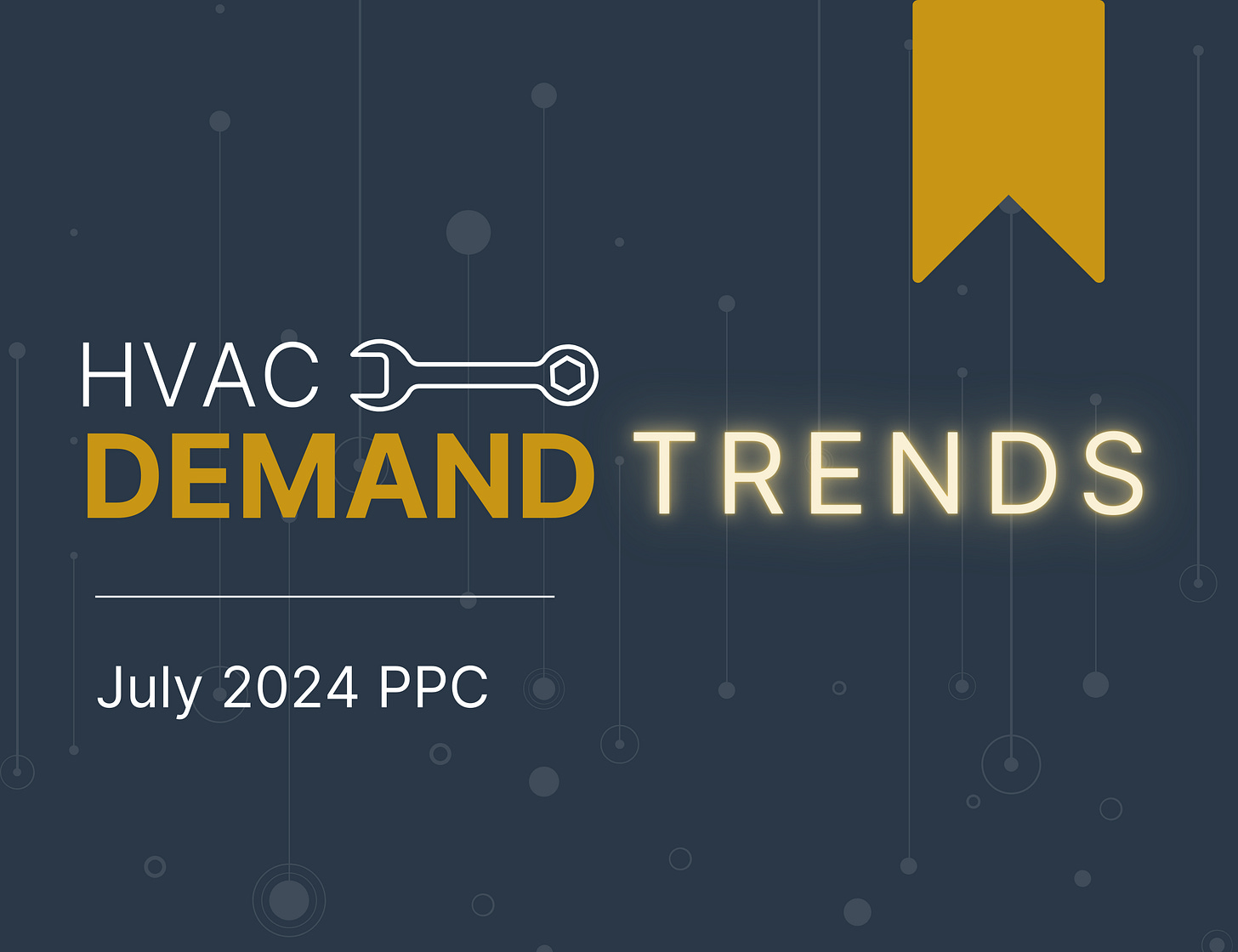HVAC Demand Trends: July 2024 PPC Performance
👋 Hey, Jon here! This week, we will analyze July 2024 PPC performance (Google and Microsoft Ads/Bing) month over month and year over year.
As a refresher, here’s the final PPC performance data from June (all of the data below is year-over-year, and keep in mind YoY June spend increased by 21%):
Conversion Volume: +16% (YoY)
Paying Customers: +22% (YoY)
Customer Acquisition Cost: -3% (YoY)
Total Revenue Opportunity: +19% (YoY)
Closed Revenue: +18% (YoY)
36% of total revenue opportunity did not convert via phone calls
Note that July spend increased 5% month-over-month and 9% year-over-year.
HVAC PPC Lead Volume Decreased by 18% Month-Over-Month and Increased by 3% Year-Over-Year
Unique lead volume from PPC saw a pretty sharp drop-off from June to July despite increased spend to capture demand from Google and Bing.
Historically (and I know this comes as no surprise to you all), June has been the strongest month for PPC, with the least expensive customer acquisition costs and the highest lead volume.
The good news is that the “excess” demand from June typically spills over into July, but the top-of-the-funnel from PPC weakened month-to-month, so if you’re feeling “slower” from this marketing channel, you aren’t alone.
It is worth noting that despite a MoM decrease in unique lead volume, year-over-year lead volume was still up by 3%.
Seasonality is a significant influence to acknowledge when analyzing data, and while year-over-year can help normalize that a bit, there were still some varying trends in different markets. For example, some brands I work with had an early heat wave last year (in May), whereas this year, it didn’t happen until late June.
In those instances, it can be helpful to extend the time period of data you are analyzing (like looking at an entire quarter). Still, one of the keys I continually refer to is that when the market is hot, make everything count and keep customers in your pipeline engaged as best as you can.
It’s hard to predict the drop-offs; sometimes, year-over-year isn’t quite apples-to-apples based on weather patterns, so keep that in mind throughout the rest of this analysis.
The month-over-month customer pipeline at crucial engagement points also slowed down: booked customers, ran jobs, and paying customers dropped by more than 15%.
Paying Customers From PPC Decreased 19% Month-Over-Month and Increased 3% Year-Over-Year
The number of paying customers was the hardest hit month-over-month, with 19% fewer in July than in June.
Average tickets did increase slightly (+3%), but not enough to compensate for the volume decrease.
Despite the volume decrease, well over 50% of revenue opportunities converted to sold/closed (a win!).
However, with 15% fewer bookings and run jobs, it was hard to make up the difference in paying customers because there weren’t as many opportunities compared to June.
Customer Acquisition Cost Increased 22% Month-over-Month and Increased 11% Year-Over-Year
The increased CAC month-over-month equated to an additional $66 to acquire a paying customer from PPC, but the slight increase in average tickets generated $90 more revenue from each paying customer, a net positive.
However, average tickets saw no change YoY, and with a higher-than-normal increase in CAC from 2023 to 2024, it turned out to be a net negative.
The balance here is weighing how much of that net-negative (in this case, about $30 more to acquire a paying customer who spent the same amount of money) you’re willing to handle while comparing to revenue volume generated and ROAS.
For example, you may be comfortable going from a 5.5x ROAS to a 5x to maintain or slightly increase total opportunities and closed revenue volume generated from a particular marketing channel.
Total PPC Revenue Opportunity Decreased 18% Month-Over-Month and Increased 7% Year-Over-Year
Although some of the year-over-year trends are unfavorable, the increase in YoY lead volume and paying customers led to 7% growth despite a near-zero change in average tickets.
However, month-over-month performance took the hardest hit, with an 18% decrease in revenue opportunity after an 11% decrease from the previous month.*
*Although revenue opportunities (estimates + sold + closed) decreased in June, closed revenue still increased.
Fewer opportunities make it harder to hit budgeted monthly goals, but it is not impossible. Focusing on improving each key step of the revenue flow journey (lead handling, booking, in-home, follow-up, etc.) with even a 1% improvement can help your business resist fluxes in upper-funnel demand.
34% of PPC Revenue Opportunity Did Not Convert via Phone Calls in July 2024
I am always fascinated by customer behavior changes and spotting those changes early to capitalize on market inefficiencies, which is why I keep putting this data point in the PPC edition of this newsletter.
We’ve seen steadily rising customer use of non-phone conversion tools like chat, online scheduling, and forms, but this time around, we saw a slight (2%) decrease in customer use of these tools and no changes YoY.
Still, over a third of the PPC revenue opportunity did not convert via phone calls, and those who provided alternatives and followed up quickly with those alternatives captured more revenue.
Closed Revenue Decreased 13% Month-Over-Month and Increased 7% Year-Over-Year
ROAS took a hit month-over-month, decreasing 20% and going from $10 of closed revenue per $1 spent to $8 of closed revenue per $1 spent.
Still, $8 in return for every $1 spent is a strong performance, not something I consider “bad”.
It’s also positive to see that year-over-year closed revenue volume still increased (it did take more spend to do so, but that’s part of the risk/reward with marketing).
As we all experience the natural come-down from peak summer, it's worth investing more of your time to keep a closer eye on your KPIs from PPC to ensure any budget and allocation changes are made to keep up with changing demand levels that align with your risk-reward ratio.
Until next time . . .
-Jon




